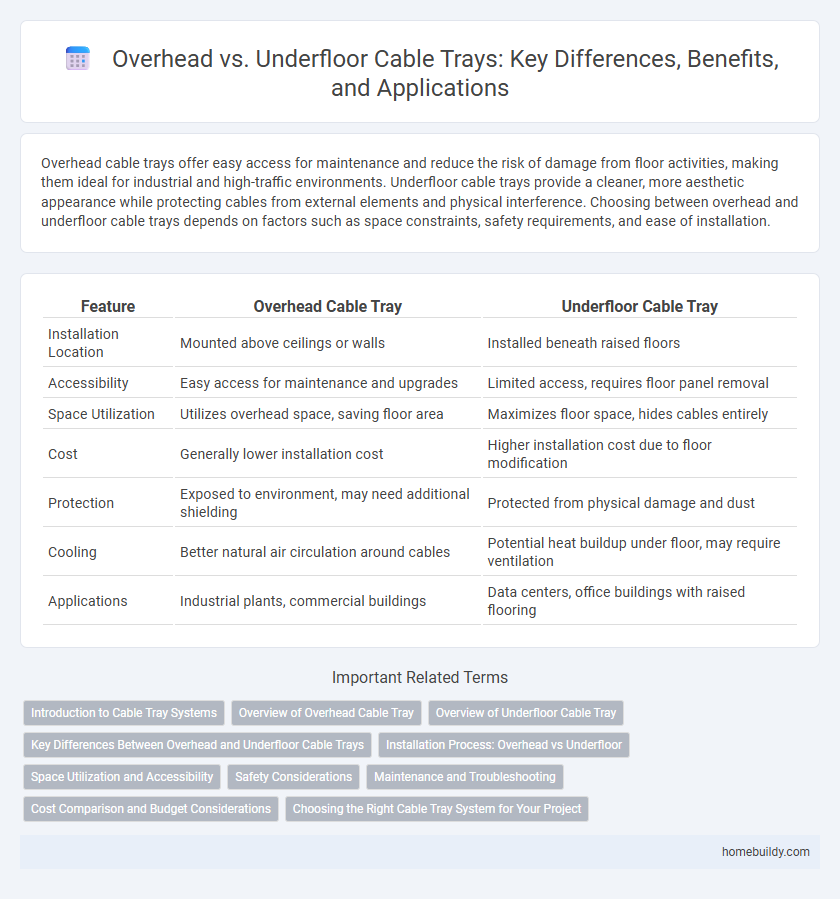Overhead cable trays offer easy access for maintenance and reduce the risk of damage from floor activities, making them ideal for industrial and high-traffic environments. Underfloor cable trays provide a cleaner, more aesthetic appearance while protecting cables from external elements and physical interference. Choosing between overhead and underfloor cable trays depends on factors such as space constraints, safety requirements, and ease of installation.
Table of Comparison
| Feature | Overhead Cable Tray | Underfloor Cable Tray |
|---|---|---|
| Installation Location | Mounted above ceilings or walls | Installed beneath raised floors |
| Accessibility | Easy access for maintenance and upgrades | Limited access, requires floor panel removal |
| Space Utilization | Utilizes overhead space, saving floor area | Maximizes floor space, hides cables entirely |
| Cost | Generally lower installation cost | Higher installation cost due to floor modification |
| Protection | Exposed to environment, may need additional shielding | Protected from physical damage and dust |
| Cooling | Better natural air circulation around cables | Potential heat buildup under floor, may require ventilation |
| Applications | Industrial plants, commercial buildings | Data centers, office buildings with raised flooring |
Introduction to Cable Tray Systems
Cable tray systems provide organized pathways for electrical wiring, improving installation efficiency and maintenance access. Overhead cable trays are installed above ground level, ideal for areas requiring clear floor space, while underfloor cable trays are embedded below floor surfaces, offering discreet cable management in environments like data centers. Choosing between overhead and underfloor systems depends on space constraints, accessibility needs, and environmental conditions to ensure optimal cable protection and system performance.
Overview of Overhead Cable Tray
Overhead cable trays provide an organized and accessible pathway for electrical cables in industrial and commercial settings, facilitating easy maintenance and upgrades. They help prevent cable damage by keeping wires elevated, reducing exposure to moisture, dirt, and mechanical impact commonly found on floors. Overhead installations optimize space utilization, improve safety by reducing trip hazards, and support extensive cable management systems for power distribution and data transmission.
Overview of Underfloor Cable Tray
Underfloor cable trays provide a concealed and organized pathway for electrical wiring beneath raised floors, enhancing workspace aesthetics and reducing trip hazards. They offer easy access for maintenance and cable management, supporting efficient modification or expansion of cable networks. Ideal for office buildings and data centers, underfloor trays protect cables from environmental damage while maintaining a clutter-free environment.
Key Differences Between Overhead and Underfloor Cable Trays
Overhead cable trays are installed above ground, providing easy access for maintenance and cooling advantages, while underfloor cable trays are embedded beneath flooring, optimizing space and protecting cables from environmental damage. Overhead trays usually support larger and heavier cables due to less space limitation, whereas underfloor trays are ideal for office or commercial buildings requiring concealed wiring. The choice between overhead and underfloor cable trays depends on factors like load capacity, environmental conditions, accessibility, and aesthetic requirements.
Installation Process: Overhead vs Underfloor
Overhead cable trays are installed by suspending them from the ceiling or structural supports, allowing easier access for maintenance and modifications with minimal disruption to floor space. Underfloor cable trays require excavation or raised flooring systems, making installation more labor-intensive and costly, but they offer concealed cable management and protection from environmental factors. The choice between overhead and underfloor installation depends on factors such as building design, accessibility requirements, and the complexity of electrical infrastructure.
Space Utilization and Accessibility
Overhead cable trays maximize space by utilizing ceiling areas, freeing up floor space for other operations, which is ideal for environments with limited ground access. Underfloor cable trays offer seamless integration with building infrastructure, ensuring cables are hidden and protected, but they can limit accessibility for maintenance and upgrades. Choosing between overhead and underfloor cable trays depends on balancing efficient space utilization with ease of accessibility for ongoing cable management.
Safety Considerations
Overhead cable trays reduce trip hazards by keeping cables elevated, ensuring safer pedestrian movement in industrial and commercial environments. Underfloor cable trays protect cables from physical damage and environmental exposure, but require careful sealing to prevent moisture ingress and potential electrical hazards. Both systems must comply with relevant electrical codes and standards to ensure optimal safety and minimize fire risks.
Maintenance and Troubleshooting
Overhead cable trays provide easier access for maintenance and troubleshooting due to their visible and reachable positioning, reducing downtime during inspections or repairs. Underfloor cable trays, while protecting cables from physical damage, often require more effort and time to access, complicating fault detection and routine maintenance. Choosing overhead trays enhances operational efficiency by streamlining cable management tasks and minimizing service interruptions.
Cost Comparison and Budget Considerations
Overhead cable trays generally have higher initial costs due to structural support requirements and installation complexity compared to underfloor cable trays, which benefit from easier accessibility and lower material expenses. Maintenance expenses for overhead trays can increase over time because of difficulty in accessing cables, whereas underfloor trays allow simpler inspections and repairs, reducing labor costs. Budget considerations must also factor in project scale and environment, as overhead trays are better suited for large industrial settings while underfloor trays fit commercial buildings with space constraints.
Choosing the Right Cable Tray System for Your Project
Overhead cable trays offer easy access for maintenance and are ideal for environments with limited floor space or high traffic, whereas underfloor cable trays provide a cleaner aesthetic and protect cables from external damage and dust. Selecting the right cable tray system depends on factors such as load capacity, environmental conditions, installation complexity, and future scalability needs. Prioritize overhead cable trays in industrial settings with frequent modifications, while underfloor trays suit commercial buildings requiring unobtrusive cable management.
Overhead cable tray vs underfloor cable tray Infographic

 homebuildy.com
homebuildy.com